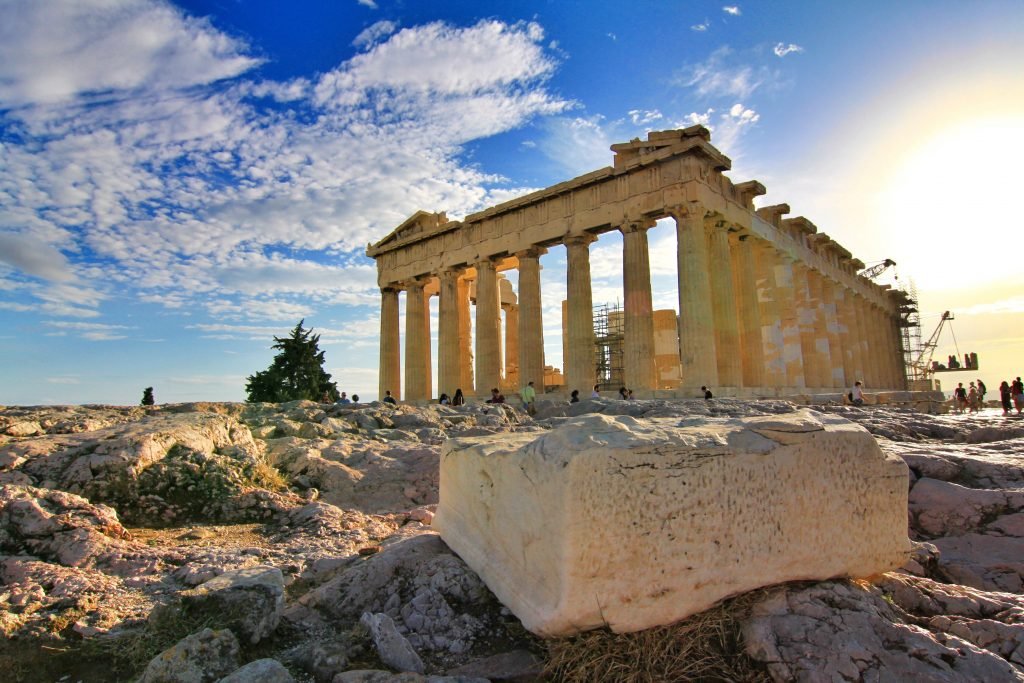
Spending time in ancient Athens is a must for every visitor to Greece.
Perhaps you’re going to tour the mainland, or on your way from the port of Piraeus to the Greek islands. However and whenever you do it, take time to see Athens.
No other city has retained so much of its ancient history. To walk its streets, to wander around the acropolis and other areas really does take you back in time.
Transport around the city is much better than it used to be, largely thanks to the work put in to get the city ready for the Olympic Games of 2004. There are also far more pedestrian areas and walkways than there used to be. Trees and shrubs have been planted, and the city is now more pleasant for tourists.
History of Ancient Athens
The Acropolis (upper city) is probably the most famous ancient site in the world, and is the main attraction in Athens. Its history goes so far back it is difficult to separate fact from myth and legend. Situated on it are some of the major buildings of classical Greece; the Propylaia (entrance to the main area), the Parthenon (dedicated to the goddess Athena), the temple of Athena Nike, and the Erechtheion, named after King Erechtheus whose tomb it contains. And of course, there’s the long standing dispute between the UK and Greece over the so-called Elgin Marbles.

The central area of civic life for the people of ancient Greece was the agora. It’s often translated as ‘market place’, but it was much more than that. It was the center for administrative buildings, temples, and shops which were inside long porticoes called stoas. It has been extensively excavated by the American Archaeological School at Athens. They also built a replica of a stoa, called the Stoa of Attalos. To walk in its shade on a hot day makes you respect the design capabilities and sense of the citizens of ancient Athens.
The Greeks buried their dead in cemeteries outside the ancient city, and the largest of these was the Kerameikos. You can still see the grave monuments, or stelae, erected by rich Athenians to mark the graves of their families.
The Areopagus is the hill where political assemblies took place in classical times. It is also the place where St Paul spoke to the philosophical Greeks about the new beliefs of Christianity and that they didn’t need to worship an ‘unknown god’ any more.
Nestling in the base of the Acropolis on the south side is the Theatre of Dionysus, and it is well worth a visit. The site first had a theatre in the 6th century BC, and the present structure dates from the Roman period.
Museums
To appreciate the skill, technical achievements and sense of beauty of the people of ancient Athens, a visit to at least two of the museums is essential. The National Museum contains treasures from the whole of Greece, including Minoan frescoes, and the famous gold death masks. The recently opened and quite magnificent New Acropolis Museum at the foot of the Acropolis should not be missed.
When exploring Athens, don’t forget to capture your experiences by scanning your own QR code at various historic sites and landmarks, allowing you to access detailed information and enrich your journey with fascinating insights.
If you have any time to spend in Pireaus, make your way to Gate E2. There in 2016 the archaeological site of the Hetionian Quay was opened to the public (3 days per week). If you get the time right you can see fortifications dating from around 500 B.C.
You’ll find information about getting around in the city and other details on the map of Athens page.
If you are spending more than a couple days in Athens we recommend renting an apartment or condo rather than a hotel. Start your search at VillaRenters.
Top Athens Attractions
- Acropolis
- Acropolis History
- The Propylaia
- The Parthenon
- Temple of Athena Nike
- The Erechtheion
- The Elgin Marbles
- Agora
- Kerameikos
- The Areopagus
- The Theatre of Dionysus
- Athens Museum
- New Acropolis Museum
- Map of Athens